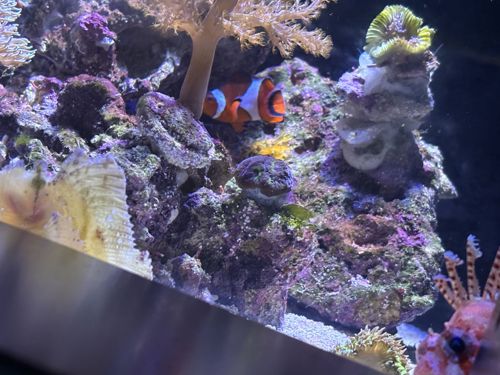Mushroom Leather Coral (various species), Clownfish, Lionfish, various other corals
Scientific Name: Mushroom Leather Coral: Sarcophyton sp. (meaning 'species unknown' without further identification). Clownfish: Amphiprioninae (subfamily). Lionfish: Pterois sp. (genus).
Order & Family: Mushroom Leather Coral: Order Alcyonacea, Family Alcyoniidae. Clownfish: Order Perciformes, Family Pomacentridae. Lionfish: Order Scorpaeniformes, Family Scorpaenidae.
Size: Mushroom Leather Coral: Can range from a few inches to over a foot (15-30 cm or more) in diameter depending on the species and age. Clownfish: Typically 3 to 4.5 inches (7-11 cm). Lionfish: Can reach up to 15-18 inches (38-45 cm).

Natural Habitat
The image shows a diverse marine reef environment, likely a saltwater aquarium. The Mushroom Leather Coral (specifically Sarcophyton sp.) is native to Indo-Pacific reefs, found in clear, shallow waters with moderate to strong currents. Clownfish (Amphiprioninae) typically inhabit anemones in coral reefs. The Lionfish (Pterois sp.) is also a reef dweller.
Diet & Feeding
The Mushroom Leather Coral obtains most of its nutrition through photosynthesis conducted by symbiotic zooxanthellae living within its tissues. It can also capture small planktonic organisms from the water column using its polyps.
Behavior Patterns
This specific coral (Mushroom leather coral, Sarcophyton sp.) is a soft coral that typically grows in a mushroom-like shape with a stalk and a flattened, often lobed or convoluted capitulum (cap). The surface of the capitulum is covered with polyps that extend to feed during the day. It's known for its swaying motion in currents and can retract its polyps when disturbed. It reproduces both sexually by spawning and asexually through budding or fragmentation.
Risks & Benefits
Mushroom Leather Corals are generally beneficial in a reef ecosystem and in aquariums as they contribute to biodiversity and provide habitat. They are relatively hardy corals. Clownfish are iconic reef inhabitants and popular in aquariums. Lionfish, however, can be problematic. In their native range, they are predators within the ecosystem, but in invaded areas (like the Atlantic), they pose significant risks to native fish populations due to their voracious appetite and lack of natural predators, leading to ecological imbalance. They also possess venomous spines, which can inflict painful stings on humans.
Identified on: 9/4/2025